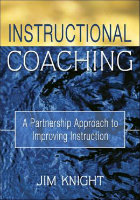How to Create Fruitful Co-Teaching Partnerships
A MiddleWeb Bog

The first goal for co-teachers is to pave the way for a successful year by establishing a learning environment that nurtures a sense of community. Some of you are skipping along a self-generated, smooth partnership pathway — while others may find themselves on shaky ground.
If you are working together by choice, it’s likely you are well into a good groove by now! In other cases, co-teachers may be working together purely because they were paired by the powers that be—with no choice in the decision. If so, you may be feeling some frustration by now. But stick with me; you can overcome it!
A forced pairing can flourish
This is the reality: most co-teachers find themselves together in the same classroom because somebody says they have to be.
Some “forced pairings” rise to the occasion and decide to just make it work. Others? Well, let’s just say that they have no desire to give it their best efforts. (Hey, it happens).
My quest to elevate co-teaching has always been to find an antidote for the feelings of resignation that frequently emerge when co-teachers are forced into a relationship. What can be learned from the co-teaching relationships that DO work and applied to these less-than-ideal situations?
This blog post is dedicated to all co-teachers – those who strive, those who hide, those who thrive, those who push back – and especially those who accept their obligation to students and feel the urge to overcome any undesirable co-teaching reality.
Jim Knight’s partnership approach
As I fall comfortably into my new position as an instructional coach, I am finding my style to be naturally in sync with Jim Knight’s ideas from his book, Instructional Coaching: A Partnership Approach to Improving Instruction. Reading the book, I cannot help but make some obvious connections to creating effective co-teaching relationships through this partnership approach.
For starters, colleagues should find common ground and engage in one-to-one meetings to get at the heart of the emotional stance and perspectives of each other. Jim Knight explains that instructional coaches keep the idea of partnership at the core—and adopting a partnership mindset is “the belief that instructional coaches are no more important than those with whom we work, and that we should do everything we can to respect that equality.” Sounds like the perfect mindset for co-teaching partners as well, don’t you think?
The Partnership Approach has seven core principles that deepen the awareness of collaboration. Here are the core principles of a partnership approach to learning as they pertain to instructional coaches.
Co-Teaching with Knight’s Core Principles
These same principles connect seamlessly to co-teaching. My hope is these seven core principles will provide a common language and mindset to guide co-teachers near and far to create their own antidote for creating dynamic learning environments.

How: Teachers can make sure that both of their names are listed together—in the room, on assignments, on notes that go home, etc. In addition, both teachers use the “we” and “our” language. Students know that there are two teachers in the room who are valued, knowledgeable, and excited to learn!
2. Choice: Co-teachers value each other’s opinions. Each teacher is part of the decision-making process. Teachers listen to one another and make instructional choices together.
How: Ideally, co-planning time is the answer. But the reality is—this time just doesn’t always fit into our busy schedules. So start with your reality and fit in time as you can. Make use of Google Docs and other mutually editable tools so you can plan asynchronously, but still together! Make the most of whatever time you have. Remember, it’s not the quantity but the quality time that counts!
3. Voice: Both co-teachers must express their points of view. Don’t be shy! Advocate for students—and also stay true to yourself to make sure your talents are in the mix of each instructional day.
How: Find your comfort zone of communication methods—and then make some noise! Perhaps it’s through email, on post-it notes as you rush out to your next class, or simply through a “how’s it going” quick debriefing. The idea is keep communication open and continuous—and most definitely a two-way street.

How: This connects to principle #3—as you find your most effective schedules and methods, begin to naturally embed meaningful conversations into whatever time is available. The idea is to make the time—start small and add time as you begin to push one another’s thinking along.
5. Reflection: Each co-teacher honors the other teacher’s need for time to connect, adopt, or adapt new ideas. Simply put…everyone needs time to think. Each co-teacher is free to choose or to reject the ideas of the other – or suggest tweaks.
How: It comes down to consideration and respect. Through your ongoing communication efforts and natural encounters, weave in this thoughtful trait of valuing each other’s thinking.
6. Praxis: Putting theory into practice. Co-teachers who are serious about “partnership” think about how to use one another’s ideas in the classroom.
How: Be flexible and ready to try out an idea that a co-teacher shares – and make sure to relinquish responsibility to one another. One teacher should not be always be carrying the weight of the instructional time.
7. Reciprocity: When we have a true partnership, everyone benefits from the success of the learning process. Each co-teacher gains greater personal insights about his own strengths and weaknesses as well as those of his partner. They begin to complement each another by balancing out their talents and skills and their needs for personal and professional growth.
How: When the other principles are consistently practiced, this principle will often just fall into place. It’s all about clear, consistent communication that values the thinking of the other professional in the room.
It’s a quadruple win

These core principles, adapted from Jim Knight’s widely regarded research work, can be the basis for a successful partnership and a dynamic learning community in any co-taught classroom.
Go on…begin to notice your thinking—your actions—and your language. How do you connect with these core principles? How can this language guide you and your co-teachers to create a Partnership Approach?































